Around the Neighborhood - Volume 1, Number 9
In 1973, Family Communications initiated a print newsletter titled Around the Neighborhood. This newspaper-like publication was largely directed towards parents but included some material for children as well. The information below documents the ninth issue.
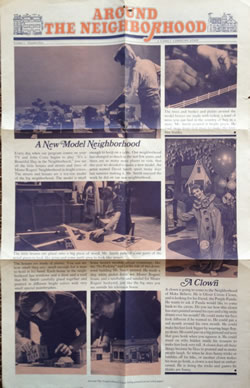
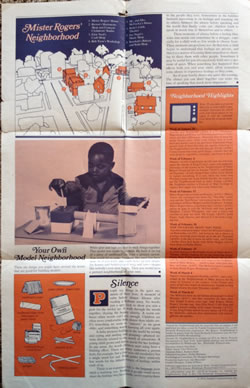
[click images for larger view]
Articles included:
- A New Model Neighborhood
- A Clown
- Mister Rogers' Neighborhood [image]
- Your Own Model Neighborhood
- Silence
- Neighborhood Highlights
Articles
Every day when our program comes on your TV and John Costa begins to play "It's a Beautiful Day in the Neighborhood," you see all the little houses and streets and trees of Mister Rogers' Neighborhood in bright colors. The streets and houses are a toy-size model of the big neighborhood. The model is small enough to keep on a table. Our neighborhood has changed so much in the last few years, and there are so many more places to visit, that this year we decided to make a new model. An artist named David Smith spent many days last summer making it. Mr. Smith enjoyed the work he did on our new neighborhood.
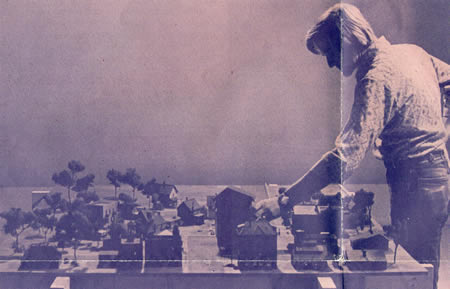
The little houses are glued onto a big piece of wood. Mr. Smith painted some parts of the wood green to look like grass and some parts gray to look like streets.
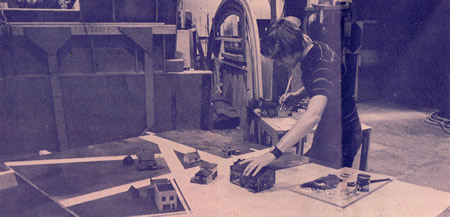
The houses are made of plastic. You can see how small they are: small enough for a man to hold in his hand. Each house in the neighborhood has windows and a door and a roof that Mr. Smith carefully glued together and painted in different bright colors with very small special paintbrushes.

Some houses needed special trimmings, like the "No Parking" sign on the side of this downtown building Mr. Smith painted. He made a tiny white picket fence for Mister Rogers' house, and a sandtable and sundial for Mister Rogers' backyard, just like the big ones you see outside his television house.
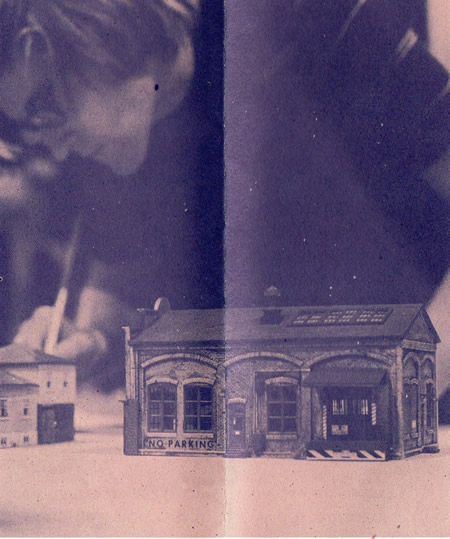
The trees and bushes and plants around the model houses are made with lichen, a kind of moss you can find in the country or buy in the store. Mr. Smith painted it bright green. He used twigs from real trees to make the little tree trunks.
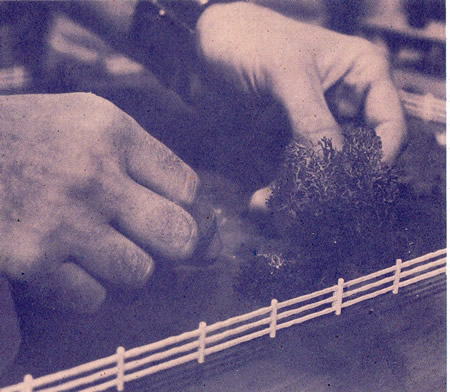
A clown is going to come to the Neighborhood of Make-Believe. He is Oliver Circus Clown, and is looking for his friend, the Purple Panda. He wants to ask if Panda would like to come back to the circus. Do you see how this clown has stars painted around his eyes and a big smile drawn over his mouth? He could make his face look different if he wanted to. He could put a sad mouth around his own mouth. He could make his feet look bigger by wearing huge floppy shoes. He could put on a big pretend red nose that goes honk when you squeeze it. He could stand on stilts hidden inside his trousers to make him look very tall. A clown does all these things because he likes to pretend and to make people laugh. So when he does funny tricks or tumbles off his bike, or another clown makes his nose go honk, a clown is not hurt or embarrassed. He is doing the tricks and games he thinks are funny.
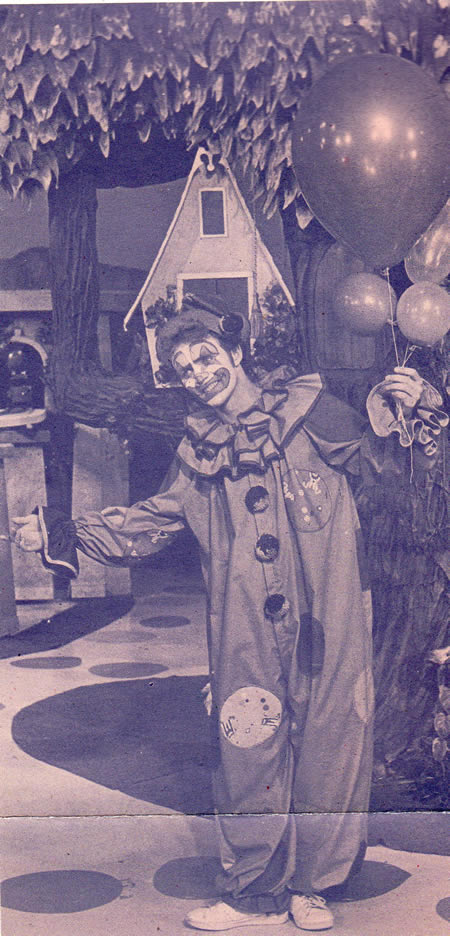

These are things you migth have around the house that are good for building models:
- cardboard scraps
- cardboard tubs from toilet paper or paper towels
- cardboard boxes, cereal boxes
- sponges
- paper plates, paper cups
- string
- popsicle sticks
- drinking straws
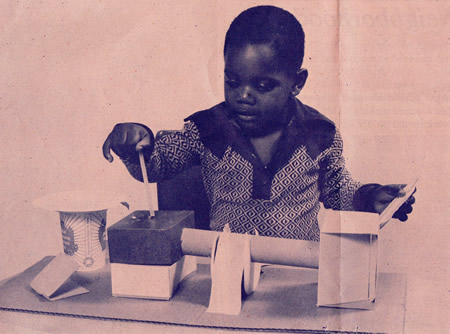
White glue and tape are best to stick things together. This model was made by a child. He built it on top of a piece of cardboard cut from a grocery carton. You could try to make buildings like ones you have seen, or, if you want, you coudl make up new shapes for houses and buildings and trees and cars -- shapes like nobody's ever seen before. Then you would have a pretend neighborhood of your own.
People say things in the quiet moments of their lives. A moment of calm before dinner. Silence after reading a bedtime story. No words, just a spry look to show you saw a grab for the cookie jar. A walk through the woods together, sharing the beauty silently. A warm embrace when words can't say enough. Children are often more comfortable with silence than adults are. It's something we seem to "unlearn" as we grow older, and something worth learning all over again.
A baby projects feelings to the world by cooing and crying and smiling and grasping -- physical actions directly related to the world of sensations. A young child grows and learns words for her feelings. In one sense, the words children start using have a limiting effect. There are many sadnesses a person feels, for example, but a four year old vocabulary has a single word for sad. Even adults have relatively few words for the infinite variety of feelings within each of us.
There is an expansive side to the language your child is learning, too. Without it people could never share the feelings they have inside, never express them to the people they love. Somewhere in the balance between narrowing in on feelings and reaching out to others, between the silence before speaking and the wods that finally come out, children learn to speak in words true to themselves and to others.
Those moments of silence before a feeling blossoms into words can sometimes be a struggle, especially for a child with so few words to choose from. These moments are precious, too. In that time a child begins to understand that feelings are private, and that it is a matter of keeping them unspoken or choosing to share them with other people. Sometimes it may be useful for you to consciously hold onto a moment of quiet. When something has happened that affects both you and your child, allow yourselves some silence to experience feelings as they come.
See if your family shares any quiet this evening. The silence you can share together can make the time of speaking that much more important.
Note: If you miss a program that you or your child is particularly interested in, check with your local station to see when it will be repeated. Give them the program number.
Week of January 28
Tuesday and Wednesday (#442 & 443) Handyman Negri helps Lady Elaine and Henrietta understand themselves and their differences -- Henrietta likes to keep her pretty dresses clean, while Lady Elaine likes to work hard and doesn't care if she gets dirty. Handyman Negri assures both of them that they are equally important to the Neighborhood just the way they are. Friday (#445) Corney learns that many good things -- whether they are work projects, vegetables, or people -- need time to grow.
Week of February 4
Monday (#446) Lady Elaine decides that she will wallpaper the outside of King Friday's castle and magically rearrange all the houses in the Neighborhood of Make-Believe. People get lost on Tuesday (#447) and finally on Thursday (#448) King Friday orders Lady Elaine to replace everything. It is only when she hears Ana Platypus crying that Lady Elaine decides she ought to put the Neighborhood back in order. Friday (#450) the Neighbors declare a Festival of Mad Feelings to express their anger over what Lady Elaine did.
Week of February 11
Mister Rogers has a visitor on Monday (#451). Morrie Turner, the cartoonist who draws the "Wee Pals" comic strip and the "Kid Power" television program. He draws caricatures of Mister Rogers and his Neighbors. Tuesday Mister Rogers shows a leg brace and crutches (#452) before he goes to visit the McFeelys and their granddaughter, Chrissy Thompson, who uses a brace and crutches to help her walk. On Friday (#455) Lady Elaine, Lady Aberlin, and Harriett E. Cow forma singing trio.
Week of February 18
NEW PROGRAMS BEGIN THIS WEEK
A professional pizza maker visits Chef Brockett's Bakery on Wednesday (#458) and everyone has a chance to practice throwing pizza dough up in the air. Thursday (#459) is the day to work on safety rules and Friday (#460) Ezra Jack Keats visits Mister Rogers with his book Dogs on Roller Skates.
Week of February 25
A clown appears in the Neighborhood of Make-Believe Tuesday (#462) looking for his lost friend the Purple Panda. King Friday agrees that the Panda can go live with the circus if the circus will come to the Neighborhood of Make-Believe...which it does, with great fanfare on Friday (#465). The McFeelys have a monkey to show Mister Rogers Wednesday (#463).
Week of March 4
Daniel's clock disappears Monday (#466), and a new-comer in the Neighborhood of Make-Believe by the name of Allmine is the suspect. Lady Elaine uses some of her own brand of mischievous wisdom to help Daniel retrieve his clock Thursday (#469).
Week of March 11
The McFeelys have an old Edison phonograph to show Monday (#471), and they remember the days when they bought it many years ago. John Rogers, Mister Rogers' younger son, visits Elsie Neal's Craft Shop and makes a plaster casting of his hands Tuesday (#472). Friday King Friday unveils this new statue (#475), and the McFeelys celebrate their anniversary with surprise gifts for one another.
Credits
Around the Neighborhood and the materials that accompany it are published ten times a year by Family Communications Inc., a not-for-profit Pennsylvania corporation. Mr. Rogers' Neighborhood is funded by grants from the Sears Foundation and the Corporation for Public Broadcasting.
Around the Neighborhood is created for FCI by Media Projects Incorporated of New York. Subscription printing and distribution accomplished by Multiscope, Inc., Pittsburgh, Pennsylvania.
Executive Editor: Sara Stein
Editor: Susan Tyler Hitchcock
Assistant Editor: Barbara Staib
Editorial Consultant: Hedda Sharapan
Psychological Consultant: Dr. Margaret McFarland
Production Supervisor: Jim Macandell
Graphic Designer: Tobias O'Mara
© 1974, Family Communications Inc.
